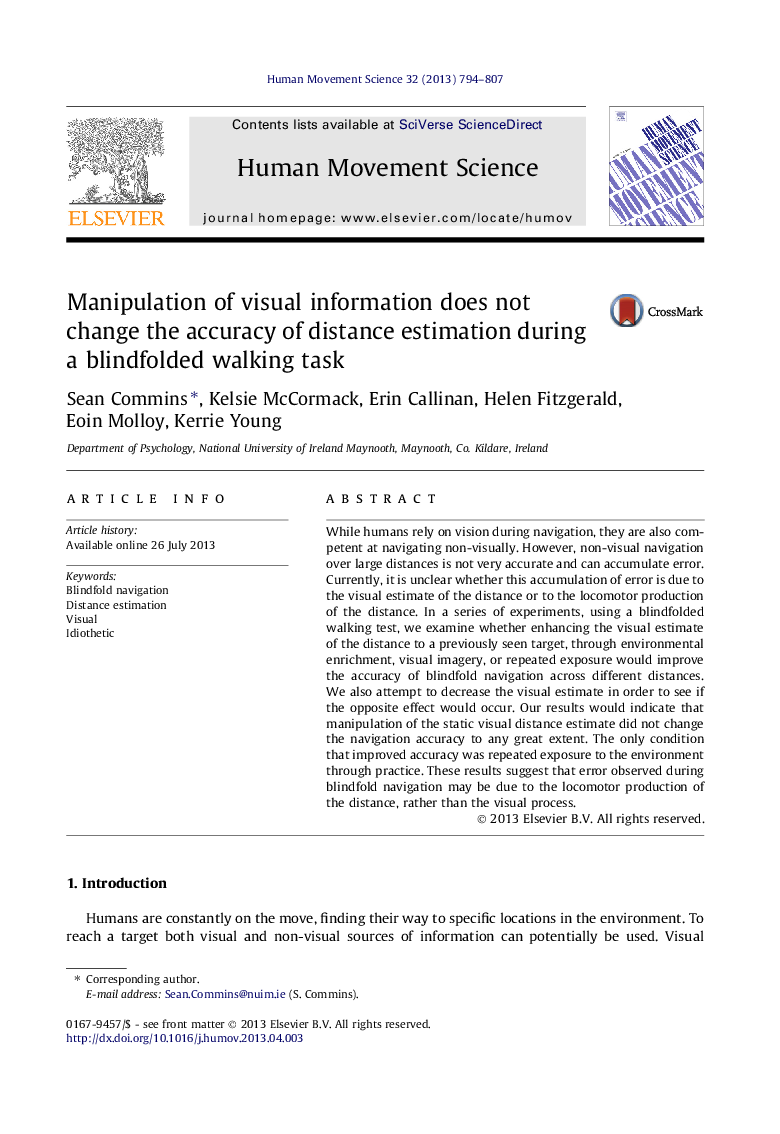| کد مقاله | کد نشریه | سال انتشار | مقاله انگلیسی | نسخه تمام متن |
|---|---|---|---|---|
| 10459205 | 922368 | 2013 | 14 صفحه PDF | دانلود رایگان |
عنوان انگلیسی مقاله ISI
Manipulation of visual information does not change the accuracy of distance estimation during a blindfolded walking task
ترجمه فارسی عنوان
دستکاری اطلاعات بصری دقت برآورد فاصله را در طول یک عمل پیاده روی چشم گیر تغییر نمی دهد
دانلود مقاله + سفارش ترجمه
دانلود مقاله ISI انگلیسی
رایگان برای ایرانیان
کلمات کلیدی
ناوبری پنهان، برآورد فاصله، دیداری، ایده آل،
ترجمه چکیده
در حالی که انسان در طول ناوبری روی دیدگاه متکی است، آنها همچنین قادر به مرور غیرمستقیم هستند. با این وجود، ناوبری غیر بصری در فواصل بزرگ بسیار دقیق نیست و می تواند خطا را تجمع دهد. در حال حاضر مشخص نیست که این تجمع خطا به دلیل تخمین بصری از فاصله یا تولید موتوری فاصله است. در یک سری از آزمایشات، با استفاده از یک آزمون پیاده روی چشم بسته، ما بررسی می کنیم که آیا ارتقاء برآورد بصری از فاصله به یک هدف قبلی که قبلا مشاهده شده است، از طریق غنی سازی محیط، تصاویر بصری و یا قرار گرفتن در معرض مکرر، دقت صحت نظارت بر چشم انداز را در فاصله های مختلف بهبود می بخشد. ما همچنین تلاش می کنیم برآورد بصری را کاهش دهیم تا ببینیم اثر متضاد چگونه رخ می دهد. نتایج ما نشان می دهد که دستکاری در تخمین فاصله بصری استاتیک دقت ناوبری را تا حد زیادی تغییر نداده است. تنها شرطی که دقت را بهبود بخشد، مواجهه با محیط زیست از طریق تمرین بود. این نتایج نشان می دهد که خطا در هنگام ناوبری چشم انداز دیده می شود به علت تولید مسیر حرکت از راه دور، به جای روند بصری.
موضوعات مرتبط
علوم زیستی و بیوفناوری
علم عصب شناسی
علوم اعصاب شناختی
چکیده انگلیسی
While humans rely on vision during navigation, they are also competent at navigating non-visually. However, non-visual navigation over large distances is not very accurate and can accumulate error. Currently, it is unclear whether this accumulation of error is due to the visual estimate of the distance or to the locomotor production of the distance. In a series of experiments, using a blindfolded walking test, we examine whether enhancing the visual estimate of the distance to a previously seen target, through environmental enrichment, visual imagery, or repeated exposure would improve the accuracy of blindfold navigation across different distances. We also attempt to decrease the visual estimate in order to see if the opposite effect would occur. Our results would indicate that manipulation of the static visual distance estimate did not change the navigation accuracy to any great extent. The only condition that improved accuracy was repeated exposure to the environment through practice. These results suggest that error observed during blindfold navigation may be due to the locomotor production of the distance, rather than the visual process.
ناشر
Database: Elsevier - ScienceDirect (ساینس دایرکت)
Journal: Human Movement Science - Volume 32, Issue 4, August 2013, Pages 794-807
Journal: Human Movement Science - Volume 32, Issue 4, August 2013, Pages 794-807
نویسندگان
Sean Commins, Kelsie McCormack, Erin Callinan, Helen Fitzgerald, Eoin Molloy, Kerrie Young,
